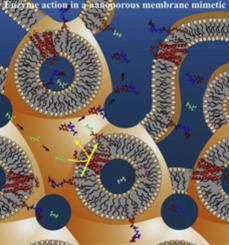Journal of Molecular Biology ( IF 4.7 ) Pub Date : 2020-02-27 , DOI: 10.1016/j.jmb.2020.02.024 Dianfan Li 1 , Martin Caffrey 2

|
The lipid cubic phase (LCP) has been used extensively as a medium for crystallizing membrane proteins. It is an attractive environment in which to perform such studies because it incorporates a lipid bilayer. It is therefore considered a useful and a faithful biomembrane mimetic. Here, we bring together evidence that supports this view. Biophysical characterizations are described demonstrating that the cubic phase is a porous medium into and out of which water-soluble molecules can diffuse for binding to and reaction with reconstituted proteins. The proteins themselves are shown to be functionally reconstituted into and to have full mobility in the bilayered membrane, a prerequisite for LCP crystallogenesis. Spectroscopic methods have been used to characterize the conformation and disposition of proteins in the mesophase. Procedures for performing activity assays on enzymes directly in the cubic phase have been reported. Specific examples described here include a kinase and two transferases, where quantitative kinetics and mechanism-defining measurements were performed directly or via a coupled assay system. Finally, ligand-binding assays are described, where binding to proteins in the mesophase membrane was monitored directly by eye and indirectly by fluorescence quenching, enabling binding constant determinations for targets with affinity values in the micromolar and nanomolar range. These results make a convincing case that the lipid bilayer of the cubic mesophase is an excellent membrane mimetic and a suitable medium in which to perform not only crystallogenesis but also biochemical and biophysical characterizations of membrane proteins.
中文翻译:

脂质立方相中膜整合蛋白的结构和功能表征。
脂质立方相(LCP)已被广泛用作结晶膜蛋白的介质。这是一个有吸引力的环境,可在其中进行此类研究,因为它包含了脂质双层。因此,它被认为是有用且忠实的生物膜模拟物。在这里,我们汇集了支持该观点的证据。描述了生物物理特征,表明立方相是一种多孔介质,水溶性分子可以扩散到多孔介质中,并与重组蛋白结合并与之反应。蛋白质本身显示出在双层膜中的功能性重构,并在双层膜中具有完全的运动性,这是LCP晶体形成的先决条件。光谱法已用于表征中间相中蛋白质的构象和配置。已经报道了直接在立方相中对酶进行活性测定的方法。这里描述的具体例子包括激酶和两种转移酶,其中直接或通过偶联测定系统进行定量动力学和机制定义测量。最后,描述了配体结合测定,其中通过肉眼直接监测与中间相膜中蛋白质的结合,并通过荧光猝灭间接监测,从而能够以微摩尔和纳摩尔范围的亲和力值确定目标的结合常数。这些结果令人信服地证明,立方中间相的脂质双层是极好的膜模拟物和合适的介质,在该介质中不仅可执行结晶生成,而且还执行膜蛋白的生化和生物物理表征。











































 京公网安备 11010802027423号
京公网安备 11010802027423号